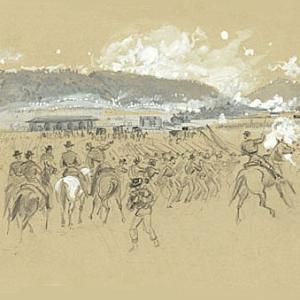
Section Branding
Header Content
Ringgold Gap Battlefield Gets National Honor
Primary Content

While I haven't (yet) visited this battlefield on Georgia Traveler, we can all celebrate this important recognition of an important Civil War site. Details from the Georgia Department of Natural Resources are below:
Ringgold Gap Battlefield Listed in the National Register of Historic Places
ATLANTA (March 21, 2011) - The Ringgold Gap Battlefield, located on White Oak Mountain, east of Ringgold and north of Interstate 75, and the northeast face of Taylor Ridge south of Interstate 75, in Ringgold, Catoosa County, Georgia, was listed in the National Register of Historic Places on March 12, 2011. The Catoosa County Historical Society sponsored the nomination and a consultant prepared the nomination materials. The Ringgold Gap Battlefield nomination was listed at the state level of significance because the Battle of Ringgold Gap played a major role in sustaining the Army of Tennessee (C.S.A.) in Georgia following the rout at the battle of Missionary Ridge in Tennessee. The battlefield and commemorative sites were evaluated within the context of Civil War battlefields and Civil War commemoration in Georgia.
On November 24-25, 1863, Union Army forces, under the command of Major General Ulysses S. Grant, routed the Army of Tennessee (C.S.A.), under the command of General Braxton Bragg, at the battles of Lookout Mountain and Missionary Ridge near the city of Chattanooga, Tennessee. The defeat forced the Confederate army to retreat into north Georgia and through Ringgold Gap in the hopes of reorganizing in the city of Dalton (Whitfield County). With portions of the Union Army in pursuit, Bragg ordered Major General Patrick Cleburne to defend Ringgold Gap to allow the Army of Tennessee's escape. On November 27, 1863, portions of the Union Army XII Corps made at least two coordinated assaults upon Confederate defenses along White Oak Mountain, Ringgold Gap, and Taylor Ridge. Cleburne's skilled defense repulsed the Union assault resulting in over 500 enemy casualties at a loss of more than 200 defenders. The battle site is significant because the Confederate victory preserved the Army of Tennessee and required Union commanders to halt their advances until the start of the Atlanta Campaign in the spring of 1864. Cleburne and his soldiers received an official letter of gratitude issued by the C.S.A. Congress for their actions. The victory also contributed to Cleburne's fame as the Confederacy's "Stonewall of the West." The site is also important in art and landscape architecture because the design and form of the 1898 New York monument and the 1937 Ringgold Gap Wayside Park represent distinctive periods of the public art of Civil War commemoration in America.
The 110-acre Ringgold Gap Battlefield contains a series of ridges and bottoms and the gap between White Oak Mountain and Taylor Ridge. The main Confederate line occupied the ridges below modern-day Clearview Drive on the southwest face of White Oak Mountain. Confederate artillery and infantry were placed in the gap on the north side of the Western & Atlantic Railroad (now CSX). A third Confederate line was located on the north end of Taylor Ridge south of South Chickamauga Creek. Deploying near the railroad, elements of the Union Army's XII Corps (approximately 12,000 soldiers) launched at least two coordinated attacks upon the west face of White Oak Mountain and into Ringgold Gap. Confederate defenders (approximately 4,100 soldiers) repulsed both assaults.
Within the boundaries of the battlefield are a monument erected in 1898 by the state of New York to commemorate the actions of the New York Brigade who fought in the battle. Also within the boundaries is a Wayside Park, begun in 1939 by the Works Progress Administration, to commemorate the 1864 Atlanta Campaign. The National Park Service completed the park in 1947. Despite the construction of houses and industrial facilities during the 20th century along the crest of White Oak Mountain and near Taylor Ridge, and the construction of Interstate 75 through the area, the core area of the battle site remains intact.
The National Register of Historic Places is our country's official list of historic buildings, structures, sites, objects, and districts worthy of preservation. The National Register provides formal recognition of a property's architectural, historical or archaeological significance. It also identifies historic properties for planning purposes and insures that these properties will be considered in the planning of state or federally assisted projects. National Register listing encourages preservation of historic properties through public awareness, federal and state tax incentives, and grants. Listing in the National Register does not place obligations or restrictions on the use, treatment, transfer, or disposition of private property.
The Historic Preservation Division (HPD) of the Georgia Department of Natural Resources serves as Georgia's state historic preservation office. Its mission is to promote the preservation and use of historic places for a better Georgia. HPD's programs include archaeology protection and education, environmental review, grants, historic resource surveys, tax incentives, the National Register of Historic Places, community planning and technical assistance.
The mission of the Department of Natural Resources is to sustain, enhance, protect and conserve Georgia's natural, historic and cultural resources for present and future generations, while recognizing the importance of promoting the development of commerce and industry that utilize sound environmental practices.





